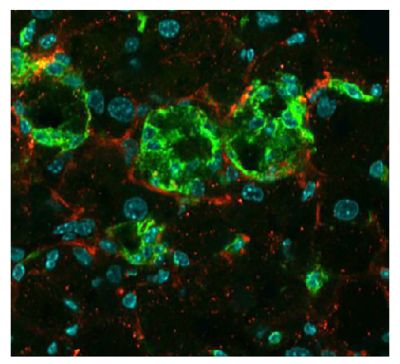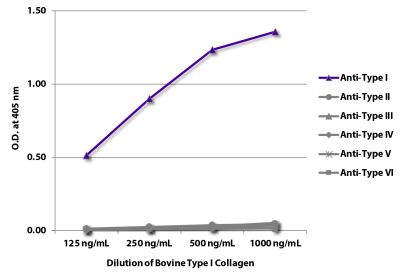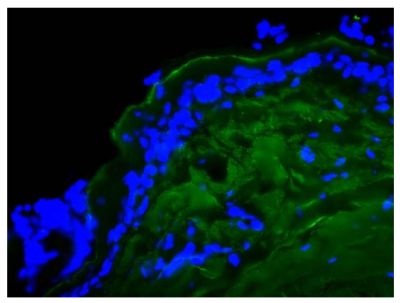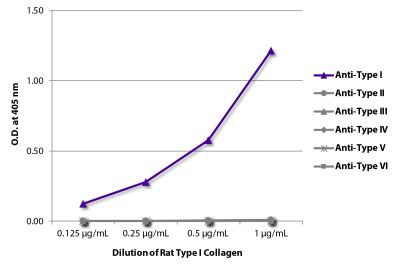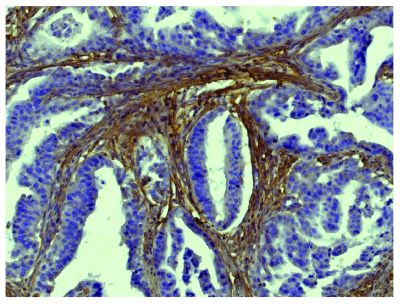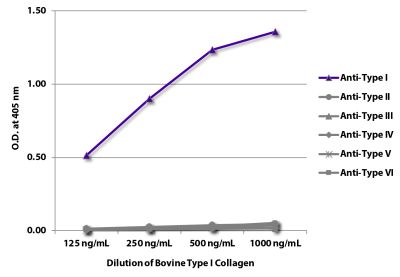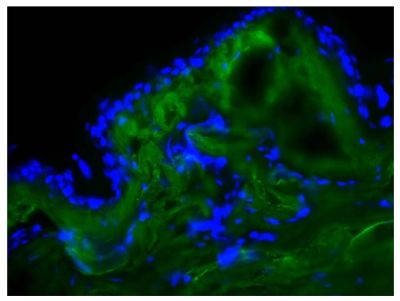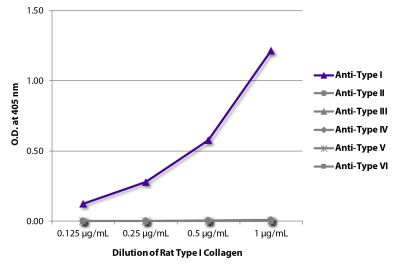Human Type I Collagen-Solution
Cat. No.:
1200-01S
Purified Human Type I Collagen solution for use as a coating material and standard.
$256.00
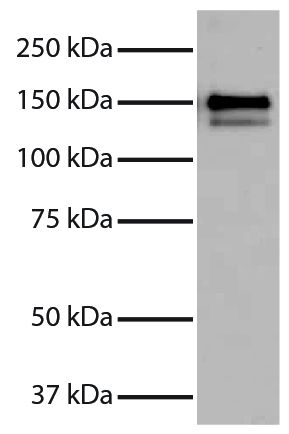

| Description | Collagen is the main structural protein in the extracellular space and is the most abundant protein in the ECM. Collagens are divided into two classes - fibril (types I, II, III, V) and non-fibril (types IV, VI). Type I collagen is the most abundant collagen and is expressed in almost all connective tissues including skin, tendon, and bone tissue. It is also the predominant component of the interstitial matrix. Type I collagen mutations are associated in a range of diseases including osteogenesis imperfecta and Ehlers-Danlos syndrome. Type I collagen consists of two α1(I) chains and one α2(I) chain. |
|---|---|
| Source | Placental villi |
| Purity | > 90% by SDS-PAGE |
| Purification Method | Controlled and limited pepsin digestion followed by selective salt precipitation |
| Buffer Formulation | 500 mM acetic acid |
| Concentration | 0.5 mg/mL |
| Volume | 1.0 mL |
| Recommended Storage | 2-8°C |
| Applications |
ELISA – Quality tested 1-15,26 SDS-PAGE – Quality tested Western Blot – Reported in literature 16,17, 20, 21 Surface Plasmon Resonance – Reported in literature 27,28 Cell Culture – Reported in literature 18,19 Stimulation Studies – Reported in literature 25 Coating Material for – Adhesion Studies – Reported in literature 20-24 Autoimmune Studies – Reported in literature 26 Blood Disorder Studies – Reported in literature 27, 28 Differentiation Studies – Reported in literature 29 ECM Interaction Studies – Reported in literature 30-32 Migration Studies – Reported in literature 33 |
Documentation
Certificate of Analysis Lookup
Enter the Catalog Number and Lot Number for the Certificate of Analysis you wish to view
- 1. Griffin M, Bhandari R, Hamilton G, Chan Y, Powell JT. Alveolar type II cell-fibroblast interactions, synthesis and secretion of surfactant and type I collagen. J Cell Sci. 1993;105:423-32. (ELISA, Standard Curve)
- 2. Rizvi MA, Katwa L, Spadone DP, Myers PR. The effects of endothelin-1 on collagen type I and type III synthesis in cultured porcine coronary artery vascular smooth muscle cells. J Mol Cell Cardiol. 1996;28:243-52. (ELISA, Standard Curve)
- 3. Rizvi MA, Myers PR. Nitric oxide modulates basal and endothelin-induced coronary artery vascular smooth muscle cell proliferation and collagen levels. J Mol Cell Cardiol. 1997;29:1779-89. (ELISA, Standard Curve)
- 4. Bumann A, Carvalho RS, Schwarzer CL, Yen EH. Collagen synthesis from human PDL cells following orthodontic tooth movement. Eur J Orthod. 1997;19:29-37. (ELISA, Standard Curve)
- 5. Myers PR, Tanner MA. Vascular endothelial cell regulation of extracellular matrix collagen: role of nitric oxide. Arterioscler Thromb Vasc Biol. 1998;18:717-22. (ELISA, Standard Curve)
- 6. Howard PS, Kucich U, Taliwal R, Korostoff JM. Mechanical forces alter extracellular matrix synthesis by human periodontal ligament fibroblasts. J Periodontal Res. 1998;33:500-8. (ELISA, Standard Curve)
- 7. Rosenbloom J, Saitta B, Gaidarova S, Sandorfi N, Rosenbloom JC, Abrams WR, et al. Inhibition of type I collagen gene expression in normal and systemic sclerosis fibroblasts by a specific inhibitor of geranylgeranyl transferase I. Arthritis Rheum. 2000;43:1624-32. (ELISA, Standard Curve)
- 8. Jimenez SA, Gaidarova S, Saitta B, Sandorfi N, Herrich DJ, Rosenbloom JC, et al. Role of protein kinase C-δ in the regulation of collagen gene expression in scleroderma fibroblasts. J Clin Invest. 2001;108:1395-403. (ELISA, Standard Curve)
- 9. Howard PS, Renfrow D, Schechter NM, Kucich U. Mast cell chymase is a possible mediator of neurogenic bladder fibrosis. Neurourol Urodyn. 2004;23:374-82. (ELISA, Standard Curve)
- 10. Absood A, Furutani A, Kawamura T, Graham LM. A comparison of oxidized LDL-induced collagen secretion by graft and aortic SMCs: role of PDGF. Am J Physiol Heart Circ Physiol. 2004;287:H1200-6. (ELISA, Standard Curve)
- 11. Kottler UB, Jünemann AG, Aigner T, Zenkel M, Rummelt C, Schlötzer-Schrehardt U. Comparative effects of TGF-β1 and TGF-β2 on extracellular matrix production, proliferation, migration, and collagen contraction of human Tenon’s capsule fibroblasts in pseudoexfoliation and primary open-angle glaucoma. Exp Eye Res. 2005;80:121-34. (ELISA, Standard Curve)
- 12. Dooley A, Gao B, Shi-Wen X, Abraham DJ, Black CM, Jacobs M, et al. Effect of nitric oxide and peroxynitrite on type I collagen synthesis in normal and scleroderma dermal fibroblasts. Free Radic Biol Med. 2007;43:253-64. (ELISA, Standard Curve)
- 13. Mishra R, Zhu L, Eckert RL, Simonson MS. TGF-β-regulated collagen type I accumulation: role of Src-based signals. Am J Physiol Cell Physiol. 2007;292:C1361-9. (ELISA, Standard Curve)
- 14. Dooley A, Shi-Wen X, Aden N, Tranah T, Desai N, Denton CP, et al. Modulation of collagen type I, fibronectin and dermal fibroblast function and activity, in systemic sclerosis by the antioxidant epigallocatechin-3-gallate. Rheumatology. 2010;49:2024-36. (ELISA, Standard Curve)
- 15. Glindtvad C, Chen M, Nygaard JV, Wogensen L, Forman A, Danielsen CC, et al. Electrospun biodegradable microfibers induce new collagen formation in a rat abdominal wall defect model: A possible treatment for pelvic floor repair?. J Biomed Mater Res B Appl Biomater. 2018;106:680-8. (ELISA, Standard Curve)
- 16. Atamas SP, Luzina IG, Choi J, Tsymbalyuk N, Carbonetti NH, Singh IS, et al. Pulmonary and activation-regulated chemokine stimulates collagen production in lung fibroblasts. Am J Respir Cell Mol Biol. 2003;29:743-9. (WB, Positive Control)
- 17. Atamas SP, Luzina IG, White B, inventors; University of Maryland, Baltimore, assignee. Therapeutic targeting of PARC/CCL18 and its signaling in pulmonary fibrosis. United States patent application publication US 2006/0009452 A1. 2006 Jan 12. (WB, Positive Control)
- 18. Zhu Y, Miller TL, Chidekel A, Shaffer TH. KL4-surfactant (Lucinactant) protects human airway epithelium from hyperoxia. Pediatr Res. 2008;64:154-8. (Cell Culture)
- 19. Chidekel A, Zhu Y, Wang J, Mosko JJ, Rodriguez E, Shaffer TH. The effects of gas humidification with high-flow nasal cannula on cultured human airway epithelial cells. Pulm Med. 2012;2012:380686. (Cell Culture)
- 20. Switalski LM, Butcher WG, Caufield PC, Lantz MS. Collagen mediates adhesion of Streptococcus mutans to human dentin. Infect Immun. 1993;61:4119-25. (Coating, Adhesion Studies, WB)
- 21. McGrady JA, Butcher WG, Beighton D, Switalski LM. Specific and charge interactions mediate collagen recognition by oral lactobacilli. J Dent Res. 1995;74:649-57. (Coating, Adhesion Studies, WB)
- 22. Burleson KM, Casey RC, Skubitz KM, Pambuccian SE, Oegema TR Jr, Skubitz AP. Ovarian carcinoma ascites spheroids adhere to extracellular matrix components and mesothelial cell monolayers. Gynecol Oncol. 2004;93:170-81. (Coating, Adhesion Studies)
- 23. Burleson KM, Boente MP, Pambuccian SE, Skubitz AP. Disaggregation and invasion of ovarian carcinoma ascites spheroids. J Transl Med. 2006;4:6. (Coating, Adhesion Studies)
- 24. Imakawa K, Imai M, Sakai A, Suzuki M, Nagaoka K, Sakai S, et al. Regulation of conceptus adhesion by endometrial CXC chemokines during the implantation period in sheep. Mol Reprod Dev. 2006;73:850-8. (Coating, Adhesion Studies)
- 25. Hawrylko E, Spertus A, Mele CA, Oster N, Frieri M. Increased interleukin-2 production in response to human type I collagen stimulation in patients with systemic sclerosis. Arthritis Rheum. 1991;34:580-7. (Stimulation Studies)
- 26. de Bruin T, de Rooster H, van Bree H, Cox E. Evaluation of anticollagen type I antibody titers in synovial fluid of both stifle joints and the left shoulder joint of dogs with unilateral cranial cruciate disease. Am J Vet Res. 2007;68:283-9. (ELISA, Coating, Autoimmune Studies)
- 27. Siekmann J, Turecek PL, Schwarz HP. The determination of von Willebrand factor activity by collagen binding assay. Haemophilia. 1998;4:15-24. (SPR, Coating, Blood Disorder Studies)
- 28. Li F, Moake JL, McIntire LV. Characterization of von Willebrand factor interaction with collagens in real time using surface plasmon resonance. Ann Biomed Eng. 2002;30:1107-16. (SPR, Coating, Blood Disorder Studies)
- 29. Andrianarivo AG, Robinson JA, Mann KG, Tracy RP. Growth on type I collagen promotes expression of the osteoblastic phenotype in human osteosarcoma MG-63 cells. J Cell Physiol. 1992;153:256-65. (Coating, Differentiation Studies)
- 30. Bidanset DJ, Guidry C, Rosenberg LC, Choi HU, Timpl R, Hook M. Binding of the proteoglycan decorin to collagen type VI. J Biol Chem. 1992;267:5250-6. (Coating, ECM Interaction Studies)
- 31. Hocking AM, Strugnell RA, Ramamurthy P, McQuillan DJ. Eukaryotic expression of recombinant biglycan. Post-translational processing and the importance of secondary structure for biological activity. J Biol Chem. 1996;271:19571-7. (Coating, ECM Interaction Studies)
- 32. Liu Z, Han X, Chen R, Zhang K, Li Y, Fruge S, et al. Microfluidic mapping of cancer cell-protein binding interaction. ACS Appl Mater Interfaces. 2017;9:22143-8. (Coating, ECM Interaction Studies)
- 33. Ji J, Zhao L, Budhu A, Forgues M, Jia H, Qin L, et al. Let-7g targets collagen type I α2 and inhibits cell migration in hepatocellular carcinoma. J Hepatol. 2010;52:690-7. (Coating, Migration Studies)
See More


